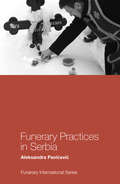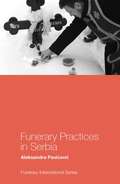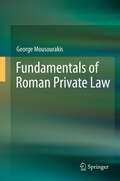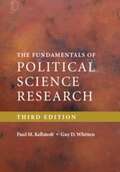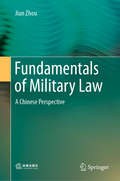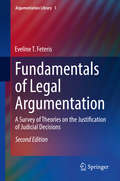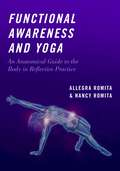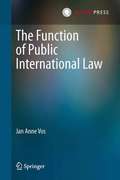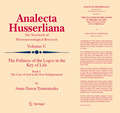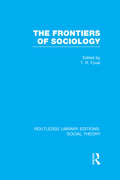- Table View
- List View
Funerary Practices in Serbia (Funerary International)
by Aleksandra PavićevićFunerary Practices in Serbia is the first book to offer a concise yet highly informative study of the historical development and current state of funerary practices in Serbia. Situated in a constant dynamic struggle between traditional cultural customs and modern legislation, funerary practices in Serbia represent a particularly interesting field of research. In this study, Pavićević combines an investigation of long-term developments and recent changes to place contemporary practices in their wider historical context, emphasizing the complicated geo-political, demographic and cultural factors that have shaped funeral traditions in Serbia over time. In particular, she demonstrates how the country's frequent changing of borders and life under the rule of two great empires - the Austro-Hungarian and Ottoman - fostered the emergence of colorful funerary traditions, such as open-casket burial and vigils around the body, that persist to this day in spite of government attempts to modernize funerary practice since the end of the 19th century. The book also provides illuminating insights into the legal framework surrounding current funerary practices in Serbia, the relationship between the state and private sectors, the ownership of cemeteries and gravesites, the role of churches and religious communities, religious and ethnic variations in funerary culture and traditions, and the development of modern cremation practices in Serbia. This book provides a useful and original resource for policymakers and practitioners interested in the historic, legal, technical and professional aspects of the Serbian funerary industry, and to researchers in cultural anthropology, history, sociology and cultural management.
Funerary Practices in Serbia (Funerary International)
by Aleksandra PavićevićFunerary Practices in Serbia is the first book to offer a concise yet highly informative study of the historical development and current state of funerary practices in Serbia. Situated in a constant dynamic struggle between traditional cultural customs and modern legislation, funerary practices in Serbia represent a particularly interesting field of research. In this study, Pavićević combines an investigation of long-term developments and recent changes to place contemporary practices in their wider historical context, emphasizing the complicated geo-political, demographic and cultural factors that have shaped funeral traditions in Serbia over time. In particular, she demonstrates how the country's frequent changing of borders and life under the rule of two great empires - the Austro-Hungarian and Ottoman - fostered the emergence of colorful funerary traditions, such as open-casket burial and vigils around the body, that persist to this day in spite of government attempts to modernize funerary practice since the end of the 19th century. The book also provides illuminating insights into the legal framework surrounding current funerary practices in Serbia, the relationship between the state and private sectors, the ownership of cemeteries and gravesites, the role of churches and religious communities, religious and ethnic variations in funerary culture and traditions, and the development of modern cremation practices in Serbia. This book provides a useful and original resource for policymakers and practitioners interested in the historic, legal, technical and professional aspects of the Serbian funerary industry, and to researchers in cultural anthropology, history, sociology and cultural management.
Funerary Practices in England and Wales (Funerary International)
by Julie Rugg Brian ParsonsThe Funerary International series comprises essential reference texts for policy-makers, practitioners and academics with an interest in funerary practices globally. Each book has a country or region specific focus, addressing a standard framework of questions to aid comparison. This book sets English and Welsh funerary practice in its wider legal, national and local governance framework, including the continuing role of the Church of England. It provides the historical context for current practice, provides data on new trends in burial and cremation and examines recent developments including direct cremation and alkaline hydrolysis. It provides detail of current practice and includes a detailed description of a typical funeral, including commemorative practice, and discussion of funeral costs. Chapters address the legalities and technicalities of burial and cremation, explaining the concept of burial rights and the technicalities of grave construction, and outlining cremation certification requirements and the process of cremation. This book is a valuable desk-top resource to give a broader frame of reference for policy makers, and to provide explanation of key concepts for practitioners who may be new to this area of work. The text will be of particular value to academics that may be unfamiliar with the legal, technical and professional aspects of the funerary industry. The text is fully referenced, with an additional bibliography of further reading, and includes illustrations, charts, tables, diagrams and boxed text including key information.
Funerary Practices in England and Wales (Funerary International)
by Julie Rugg Brian ParsonsThe Funerary International series comprises essential reference texts for policy-makers, practitioners and academics with an interest in funerary practices globally. Each book has a country or region specific focus, addressing a standard framework of questions to aid comparison. This book sets English and Welsh funerary practice in its wider legal, national and local governance framework, including the continuing role of the Church of England. It provides the historical context for current practice, provides data on new trends in burial and cremation and examines recent developments including direct cremation and alkaline hydrolysis. It provides detail of current practice and includes a detailed description of a typical funeral, including commemorative practice, and discussion of funeral costs. Chapters address the legalities and technicalities of burial and cremation, explaining the concept of burial rights and the technicalities of grave construction, and outlining cremation certification requirements and the process of cremation. This book is a valuable desk-top resource to give a broader frame of reference for policy makers, and to provide explanation of key concepts for practitioners who may be new to this area of work. The text will be of particular value to academics that may be unfamiliar with the legal, technical and professional aspects of the funerary industry. The text is fully referenced, with an additional bibliography of further reading, and includes illustrations, charts, tables, diagrams and boxed text including key information.
Fundamentals of Roman Private Law
by George MousourakisRoman law forms a vital part of the intellectual background of many legal systems currently in force in Continental Europe, Latin America, East Asia and other parts of the world. Knowledge of Roman law, therefore, constitutes an essential component of a sound legal education as well as the education of the student of history. This book begins with a historical introduction, which traces the evolution of Roman law from the earliest period of Roman history up to and including Justinian's codification in the sixth century AD. Then follows an exposition of the principal institutions of Roman private law: the body of rules and principles relating to individuals in Roman society and regulating their personal and proprietary relationships. In this part of the book special attention is given to the Roman law of things, which forged the foundations for much of the modern law of property and obligations in European legal systems. Combining a law specialist's informed perspective with a historical and cultural focus, the book provides an accessible source of reference for students and researchers in many diverse fields of legal and historical learning.
Fundamentals of Psychology: An Introduction
by Michael S. GazzanigaFundamentals of Psychology: An Introduction focuses on issues that cut through the artificial boundaries commonly held in the study of behavior. The book reviews the nature of the organism in terms of basic neurology, including the neurological organization of the central nervous system and the general features of brain development. The author also examines the normal course of development of the visual systems. He discusses fixed patterns of behavior and the developmental processes that include emotional behavior, self-control, language use, perceptual, and cognitive development. The author then explains the use of statistical concept in psychological research, as well as the psychological methods of inquiry that involves variable manipulation and observation of effects. The author also discusses learning and motivation theory including the theories of Pavlov, Skinner, and Premack. He discusses the organism as an information processor using short- and long-term memory, and the mind as having physical aspects such as brain codes and a brain structure known as the corpus callosum. This book is helpful for psychiatrists, psychologists, behavioral scientists, students and professors in psychology.
The Fundamentals Of Political Science Research (PDF)
by Paul M. Kellstedt Guy D. WhittenThe third edition of the best-selling The Fundamentals of Political Science Research provides an introduction to the scientific study of politics. It offers the basic tools necessary for readers to become both critical consumers and beginning producers of scientific research on politics. The authors present an integrated approach to research design and empirical analyses whereby researchers can develop and test causal theories. They use examples from political science research that students will find interesting and inspiring, and that will help them understand key concepts. The book makes technical material accessible to students who might otherwise be intimidated by mathematical examples. This revised third edition features new 'Your Turn' boxes meant to engage students. The edition also has new sections added throughout the book to enhance the content's clarity and breadth of coverage.
Fundamentals of Military Law: A Chinese Perspective
by Jian ZhouThe book makes a comprehensive analysis of the basic principles and theories of military law, restructuring the theoretic framework of military law. It also puts forwards the new concepts of “core military law” and “international military law” for the first time in China, and even the world. The book could help legal scholars and lawyers, especially military lawyers and research fellows in military law, to have a new approach to study military law.
Fundamentals of Legal Argumentation: A Survey of Theories on the Justification of Judicial Decisions (Argumentation Library #1)
by Eveline T. FeterisThis book is an updated and revised edition of Fundamentals of Legal Argumentation published in 1999. It discusses new developments that have taken place in the past 15 years in research of legal argumentation, legal justification and legal interpretation, as well as the implications of these new developments for the theory of legal argumentation. Almost every chapter has been revised and updated, and the chapters include discussions of recent studies, major additions on topical issues, new perspectives, and new developments in several theoretical areas. Examples of these additions are discussions of recent developments in such areas as Habermas' theory, MacCormick's theory, Alexy's theory, Artificial Intelligence and law, and the pragma-dialectical theory of legal argumentation. Furthermore it provides an extensive and systematic overview of approaches and studies of legal argumentation in the context of legal justification in various legal systems and countries that have been important for the development of research of legal argumentation.The book contains a discussion of influential theories that conceive the law and legal justification as argumentative activity. From different disciplinary and theoretical angles it addresses such topics as the institutional characteristics of the law and the relation between general standards for moral discussions and legal standards such as the Rule of Law. It discusses patterns of legal justification in the context of different types of problems in the application of the law and it describes rules for rational legal discussions.The combination of the sound basis of the first edition and the discussions of new developments make this new edition an up-to-date and comprehensive survey of the various theoretical influences which have informed the study of legal argumentation. It discusses salient backgrounds to this field as well as major approaches and trends in the contemporary research. It surveys the relevant theoretical factors both from various continental law traditions and common law countries.
Fundamentals of Legal Argumentation: A Survey of Theories on the Justification of Judicial Decisions (Argumentation Library #1)
by Eveline T. FeterisLegal argumentation is a distinctively multidisciplinary field of inquiry. It draws its data, assumptions and methods from disciplines such as legal theory, legal philosophy, logic, argumentation theory, rhetoric, linguistics, literary theory, philosophy, sociology, and artificial intelligence. This presents the growing group of interested scholars and students with a problem of access, since, even for those active in the field, it is not common to have acquired a familiarity with relevant aspects of each discipline that enters into this multidisciplinary matrix. Fundamentals of Legal Argumentation offers its readers a unique and comprehensive survey of the various theoretical influences which have informed the study of legal argumentation. It discusses salient backgrounds to this field as well as all major approaches and trends in the contemporary research. It surveys relevant theoretical factors both from various continental law traditions and common law countries.
Fundamentals of Internet of Things for Non-Engineers (Technology for Non-Engineers)
by Rebecca Lee Hammons Ronald J. KovacThe IoT is the next manifestation of the Internet. The trend started by connecting computers to computers, progressed to connecting people to people, and is now moving to connect everything to everything. The movement started like a race—with a lot of fanfare, excitement, and cheering. We’re now into the work phase, and we have to figure out how to make the dream come true. The IoT will have many faces and involve many fields as it progresses. It will involve technology, design, security, legal policy, business, artificial intelligence, design, Big Data, and forensics; about any field that exists now. This is the reason for this book. There are books in each one of these fields, but the focus was always "an inch wide and a mile deep." There’s a need for a book that will introduce the IoT to non-engineers and allow them to dream of the possibilities and explore the work venues in this area. The book had to be "a mile wide and a few inches deep." The editors met this goal by engaging experts from a number of fields and asking them to come together to create an introductory IoT book. Fundamentals of Internet of Things for Non-Engineers Provides a comprehensive view of the current fundamentals and the anticipated future trends in the realm of Internet of Things from a practitioner’s point of view Brings together a variety of voices with subject matter expertise in these diverse topical areas to provide leaders, students, and lay persons with a fresh worldview of the Internet of Things and the background to succeed in related technology decision-making Enhances the reader’s experience through a review of actual applications of Internet of Things end points and devices to solve business and civic problems along with notes on lessons learned Prepares readers to embrace the Internet of Things era and address complex business, social, operational, educational, and personal systems integration questions and opportunities
Fundamentals of Internet of Things for Non-Engineers (Technology for Non-Engineers)
by Rebecca Lee Hammons Ronald J. KovacThe IoT is the next manifestation of the Internet. The trend started by connecting computers to computers, progressed to connecting people to people, and is now moving to connect everything to everything. The movement started like a race—with a lot of fanfare, excitement, and cheering. We’re now into the work phase, and we have to figure out how to make the dream come true. The IoT will have many faces and involve many fields as it progresses. It will involve technology, design, security, legal policy, business, artificial intelligence, design, Big Data, and forensics; about any field that exists now. This is the reason for this book. There are books in each one of these fields, but the focus was always "an inch wide and a mile deep." There’s a need for a book that will introduce the IoT to non-engineers and allow them to dream of the possibilities and explore the work venues in this area. The book had to be "a mile wide and a few inches deep." The editors met this goal by engaging experts from a number of fields and asking them to come together to create an introductory IoT book. Fundamentals of Internet of Things for Non-Engineers Provides a comprehensive view of the current fundamentals and the anticipated future trends in the realm of Internet of Things from a practitioner’s point of view Brings together a variety of voices with subject matter expertise in these diverse topical areas to provide leaders, students, and lay persons with a fresh worldview of the Internet of Things and the background to succeed in related technology decision-making Enhances the reader’s experience through a review of actual applications of Internet of Things end points and devices to solve business and civic problems along with notes on lessons learned Prepares readers to embrace the Internet of Things era and address complex business, social, operational, educational, and personal systems integration questions and opportunities
The Fundamentals of Drawing Nudes: A Practical Guide to Portraying the Human Figure
by Barrington BarberThe bold form of the human figure has inspired artists for centuries, providing endless variety and interest. In this inspirational workbook, author and artist Barrington Barber provides an accessible introduction to life drawing.After reading this book, you will be able to:• Precisely depict the skeleton and musculature• Use perspective to create realistic images• Correctly gauge figure proportions and foreshorten limbs• Portray figures in movement• And more!Examples from master artists such as Giorgione, Manet and Freud show the range of materials and stylistic approaches to life drawing. With carefully annotated diagrams, simple exercises and a handy list of anatomical terms, The Fundamentals of Drawing Nudes gives you everything you need to draw your own realistic figures. This book is perfect for both budding and professional artists, providing tips and tricks to mastering this subtle art.
The Fundamentals of Design Management (Fundamentals)
by Kathryn BestThe book explicitly places the principles and processes of design within the context of a business or enterprise, explaining how design management can relate to the cultural, environmental, political and social impact of an enterprise. It emphasises the inter-disciplinary nature of design management, and as such is of relevance to students of a number of disciplines: from art and design to business, marketing or media. The Fundamentals of Design Management is supported throughout by a range of interviews and case studies, taken from design practitioners and industry experts.
The Fundamentals of Design Management (Fundamentals)
by Kathryn BestThe book explicitly places the principles and processes of design within the context of a business or enterprise, explaining how design management can relate to the cultural, environmental, political and social impact of an enterprise. It emphasises the inter-disciplinary nature of design management, and as such is of relevance to students of a number of disciplines: from art and design to business, marketing or media. The Fundamentals of Design Management is supported throughout by a range of interviews and case studies, taken from design practitioners and industry experts.
The Fundamental Concept of Crime in International Criminal Law: A Comparative Law Analysis
by Iryna MarchukThis book examines the rapid development of the fundamental concept of a crime in international criminal law from a comparative law perspective. In this context, particular thought has been given to the catalyzing impact of the criminal law theory that has developed in major world legal systems upon the crystallization of the substantive part of international criminal law. This study offers a critical overview of international and domestic jurisprudence with regard to the construal of the concept of a crime (actus reus, mens rea, defences, modes of liability) and exposes roots of confusion in international criminal law through a comprehensive comparative analysis of substantive criminal laws in selected legal jurisdictions.
Functions: From Organisms to Artefacts (History, Philosophy and Theory of the Life Sciences #32)
by Jean Gayon Armand De Ricqlès Antoine C. DussaultThis book, originally published in French, examines the philosophical debates on functions over the last forty years and proposes new ways of analysis. Pervasive throughout the life sciences, the concept of function has the air of an epistemological scandal: ascribing a function to a biological structure or process amounts to suggesting that it is explained by its effects. This book confronts the debates on function with the use of the notion in a wide range of disciplines, such as biology, psychology, and medicine. It also raises the question of whether this notion, which is as old in the history of technology as it is in the life sciences, has the same meaning in these two domains.
FUNCTIONAL AWARENESS & YOGA C: An Anatomical Guide to the Body in Reflective Practice
by Nancy Romita Allegra RomitaFunctional Awareness and Yoga is an essential book for all who wishes to deepen their yoga practice and discover strategies to reduce strain or discomfort on the mat as well as in daily life. It is also an excellent book of introductory concepts in anatomy as applied to yoga required during a yoga teacher training. Each chapter provides essentials in functional anatomy with over 60 practical illustrations. The chapters also apply specific postures in yoga with cues to support the practice on the mat. Finally, each chapter contains a mindful practice section to help readers integrate anatomical imagery into daily life in order to release unnecessary tension, improve posture, and support ease of movement. The reflective practice of Functional Awareness® changes how one goes through simple daily tasks in living and demonstrates how these small simple shifts can have a profound effect on ease in action and resilience in movement both on and off the yoga mat. Guiding readers through the essentials in body alignment by providing engaging explorations in body/mind awareness, the book offers a pathway to improve resilience and balance in action.
Functional Awareness and Yoga: An Anatomical Guide to the Body in Reflective Practice
by Nancy Romita Allegra RomitaFunctional Awareness and Yoga is an essential book for all who wishes to deepen their yoga practice and discover strategies to reduce strain or discomfort on the mat as well as in daily life. It is also an excellent book of introductory concepts in anatomy as applied to yoga required during a yoga teacher training. Each chapter provides essentials in functional anatomy with over 60 practical illustrations. The chapters also apply specific postures in yoga with cues to support the practice on the mat. Finally, each chapter contains a mindful practice section to help readers integrate anatomical imagery into daily life in order to release unnecessary tension, improve posture, and support ease of movement. The reflective practice of Functional Awareness® changes how one goes through simple daily tasks in living and demonstrates how these small simple shifts can have a profound effect on ease in action and resilience in movement both on and off the yoga mat. Guiding readers through the essentials in body alignment by providing engaging explorations in body/mind awareness, the book offers a pathway to improve resilience and balance in action.
The Function of Public International Law
by Jan Anne VosThis book addresses fundamental aspects of the concept of public international law in both theory and practice. The argument developed by the author is that, underlying the traditional, horizontal, structure of public international law, a vertical structure of the concept of law may be discerned. This vertical structure is seen unfolding into two, mutually exclusive, frameworks: a framework of obligation, accounting for obligations, and a framework of authorization, accounting for rights. The problem then arising is that a concept of public international law which only admits either rights or obligations cannot be regarded as coherent. The author, however, takes and substantiates the position that coherence can be achieved by suppressing the mutual exclusivity of both frameworks. This move paves the way to formulating the function of public international law in terms of the constituting of international society. Since in public international law the theoretical aspects profoundly affect practice, this book is not only of interest to academics, but also for practitioners, such as officials of foreign offices and international institutions.
The Fullness of the Logos in the Key of Life: Book I The Case of God in the New Enlightenment (Analecta Husserliana #100)
by Anna-Teresa TymienieckaLamentations over the disarray and disorientation in the philosophical quest may be heard from all sides today. The horizon of the All no longer beacons, for our hope of attaining it seems ever to recede. Yet, challenging the mistrust of reason that pursuit is precisely engaged in what is undertaken here. Our forty–year elaboration of the ontopoiesis/phenomenology of life as first philosophy/phenomenology in its unravelling of the metamorphic deployment of the logos of life has laid the foundations for the retrieval of the metaphysical vision. Here the classic concerns of philosophy are not negligently dismissed but are ciphered afresh in the light of innumerable perspectives and insights brought to philosophical attention in a New Enlightenment by advances in the sciences of life and of human apprehension. Strikingly enough pursuit of the greatest enigma of all, namely, that of the All enhancing Divine, is revived in the revelation that the logos informing life is the Fullness of God. In the Fullness being revealed in the infinite intricacies of the operations of the Logos of Life, we find the plenitude of God’s experiencing man. In times when the prevailing critique of reason casts aspersions on the quest for God through reason, the full revelation of the logos brings to the entire human experience the infinities of God.
Fucking Good Manners
by Simon GriffinThis is not a book about how to be posh. We have some slightly bigger issues to deal with these days. We’ve all got a million things to do and are constantly connected to millions of other people all doing a million other things, so the faster we get things done the better, right? Wrong. Among all the busyness and confusion it seems we’ve forgotten a few of the basics in life, like the ability to treat one another with respect, dignity and some fucking good manners. Enter Simon Griffin, author of Fucking Apostrophes. From the entry-level stuff like saying please, thank you and sorry; manspreading on public transport and double-lane queuing at airports, to those that require just a little bit more thought, such as correct urinal protocol in public toilets, making tea rounds in the office and online public displays of affection, Simon imparts rules and advice to living life in a way that makes it just a bit better for everyone. With some liberal use of rude words thrown in to emphasise the point. With chapters on driving, social media, the environment, getting on with your neighbours, and the best manners for a trip to the cinema, this is the perfect gift for a manners enthusiast, or those in need of a gentle (but sweary) nudge in the right direction.
Fuck You, 2016
by Bob A. GrypantsIn the year that David Bowie died, Brexit shocked us, 'Hiddleswift' was a thing and Trump trumped, we are all asking ourselves was 2016 really the worst year ever? Find out in this special* commemorative book**.Inside this cathartic memento of the annus shitabulus that was 2016 you'll find a hilarious guide to everything that went wrong and the few - very few - things that actually went right. For example:- How was it that politics completely jumped the shark this year?- From Bowie to Prince, Ali to Cohen, we celebrate the many extraordinary artists who died rather than see Trump become President (Did Castro make it into the book? Close, but no cigar)- Compare 2016 with other terrible years in history - is it really the very worst?- Make sense of Manbuns, Pokemon Go, Hygge, Nigel Farage and other nonsense- With the aid of an electron microscope we hunt for something good that actually happened- Feel relieved about all the bad things that didn't occur - yet (there's always 2017, folks!)Featuring some really badly drawn illustrations, this comic compendium will soothe your troubled soul - before you throw it in the bin and prepare your mightily hungover self to face 2017. It has to be better, right?* i.e. hastily put together** Warning: this book will spontaneously combust at midnight on December 31st 2016
Fruit and Vegetables for Scotland: What to Grow and How to Grow It
by Ken Cox Caroline BeatonFruit and vegetables have formed a fundamental part of the Scottish diet for thousands of years. This fascinating and practical book explores the history of fruit, vegetable and herb growing in Scotland, and provides a contemporary guide to the best techniques for growing produce, whether in a garden, allotment, patio or window box. Packed with hundreds of colour photographs, drawings and descriptive diagrams, this is a detailed and comprehensive bible for the gardener. In addition to advice on climate and soil conditions, it has contacts for organisations, specialist societies, nurseries and suppliers, as well as a detailed bibliography and list of useful websites.This is an essential reference book for anyone aiming to get the best possible results from their garden produce north of the border.
The Frontiers of Sociology (RLE Social Theory)
by T. R. FyvelThe six essays in this volume are designed to introduce the general reader to some of the main issues in the fields of education, industry, politics, family changes and the like, which concern British sociologists. While each of the essays is independently conceived, their joint aim is to show how sociologists can use empirical methods to throw fresh light on current social problems and also to convey the distinctive approach, the distinctive view of the world towards which sociologists are striving.
